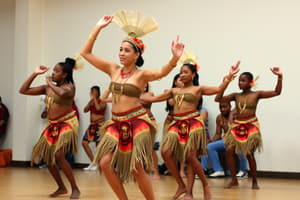Podcast
Questions and Answers
What does the word 'dance' derive from?
What does the word 'dance' derive from?
- A Latin word meaning to express
- A French word meaning 'to perform'
- An ancient Greek word meaning 'to move'
- A German word 'danson' meaning 'to stretch' (correct)
Dance can improve physical health by enhancing cardiovascular endurance.
Dance can improve physical health by enhancing cardiovascular endurance.
True (A)
Name one cultural benefit of dance.
Name one cultural benefit of dance.
It promotes understanding and appreciation of different cultures.
The _____ aspect of dance emphasizes social interaction and group involvement.
The _____ aspect of dance emphasizes social interaction and group involvement.
Which of the following is NOT an element of dance?
Which of the following is NOT an element of dance?
Match the classifications of dance with their descriptions:
Match the classifications of dance with their descriptions:
Dance does not have any impact on mental health.
Dance does not have any impact on mental health.
Identify one physical benefit of practicing dance regularly.
Identify one physical benefit of practicing dance regularly.
Flashcards are hidden until you start studying
Study Notes
Introduction to Physical Dance Education
- The term "dance" originates from the German word “danson,” meaning "to stretch."
- Dance involves rhythmic movement patterns.
Aspects of Dance
-
Physical Aspect
- Regular dance practice enhances cardiovascular and muscular endurance.
- Improves body composition, balance, and flexibility.
-
Mental and Emotional Aspect
- Dance serves as an intervention in mental health, providing emotional and physical release.
- Referenced by Ravelin et al. (2006), dance is considered a therapeutic tool in nursing.
-
Social Aspect
- Promotes group involvement and fosters positive social interactions.
- Encourages the development of interpersonal relationships within working groups.
-
Cultural Aspect
- Showcases the cultural richness of a place through traditional dances.
- Facilitates understanding and appreciation of different folk cultures globally.
Elements of Dance (B.A.S.T.E.)
-
Body
- The primary instrument for all forms of dance.
-
Action
- Encompasses the execution of various dance steps and movements.
-
Space
- Refers to the venues and platforms where dancing occurs.
-
Time
- Indicates the rhythm or beat that underlies the dance movements.
-
Energy
- Describes the intensity and dynamism of the dance performance.
Classifications of Dance
-
Folk Dance
- Reflects the cultural life and traditions of specific countries or regions.
-
Social Dance
- Known as "ballroom dance," includes standardized social dances like Foxtrot, Tango, Swing, and Cha-Cha.
-
Cheer Dance
- Represents the dance segment of cheerleading, excluding tumbling and stunts.
Studying That Suits You
Use AI to generate personalized quizzes and flashcards to suit your learning preferences.




